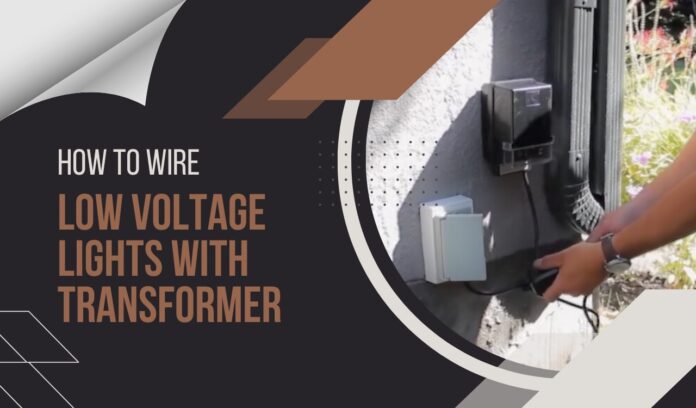Need to know how to wire low voltage lights with transformer? Well, we have tried to make it all easy for our readers!
Wiring low-voltage landscape lights with a transformer require quite a lot of technical knowledge. Once the technicalities are understood, the wiring becomes a piece of cake.
The wiring depends upon the size of the property, the number of lights and then according to that, the size of the transformer can be picked.
What Is The Purpose of a Low Voltage Transformer?
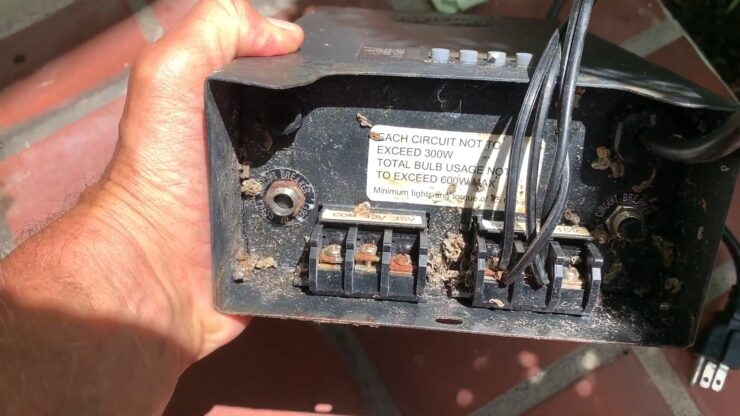
Almost all households have a power supply of 120v. This power is suitable for the lights inside the house that require a higher voltage.
However, landscape lighting requires lower voltage hence a low-voltage transformer is needed.
A low-voltage transformer converts the 120v of power into the low-voltage that is needed by each of the fixtures of the landscape lighting. The low-voltage may be as low as 12v and it ends up being beneficial.
If your Zenith motion sensor light is not working you can try our solutions.
There are two benefits of low-voltage landscape lighting:
# Less power or electricity is used
Since less power is used, it becomes cost-effective and doesn’t lead to a spike in electricity bills.
# No electrical hazard
The low-voltage landscape lighting is beneficial because it doesn’t have electrical hazard risks.
The Comparison Table of 6 Best Low Voltage Wire 2024
Choosing The Best Low Voltage Transformer
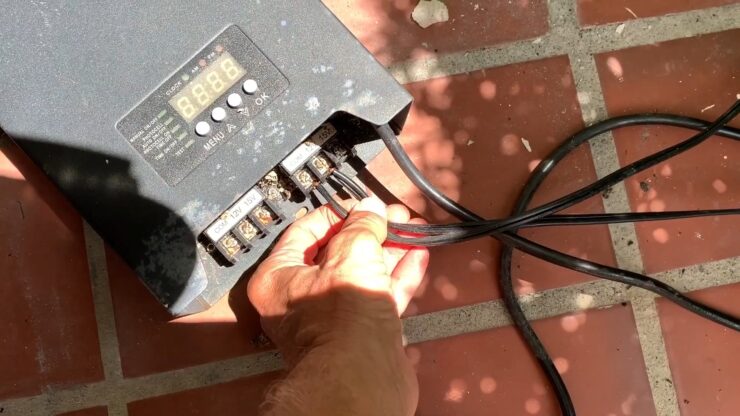
To be able to pick out the best low-voltage transformer, you need to make some simple calculations.
First, you need to figure out which fixtures and lights you need and how many of them do you need on your property.
Make sure to not add an unnecessary number of lights. Add only the needed number. The greater number of lights will require a bigger transformer as well.
What you need to be careful about is that each fixture requires a specific number of watts. On the other hand, each transformer has a specific number of watts that it can support.
So, the whole idea is that the transformer must be able to support the watts needed by all the fixtures.
The total wattage that the fixtures require or consume has to be calculated. After that, the transformer that sustains or supports that total wattage can be easily picked.
How to Wire Low Voltage Lights With Transformer
Formul Number of watts per fixture X Number of lights= Total number of watts that the transformer must support
First, you need to pick out the right side of the transformer depending upon the watts of the fixture.
After that, the length of the wire for each fixture should be equal between each fixture so that a voltage drop can be avoided.
Then the wires from the fixture can be connected to the transformer and the wiring will be completed.
The wire from Southwire or Lightwiki
Two of the most strong and powerful wires are from Southwire and Lightwiki.
Here are the descriptions of each:
01. Southwire
This wire is made with a blend of aluminum and copper, due to this it is very strong. Since it is low-voltage, it becomes versatile.
It can be used for a variety of purposes such as; accent lights, garden lights, and even spotlights. Its long-lasting durability deserves praise because of its vinyl jacket.
It makes the wire dirt, dust, and water-proof. It also has the ability to withstand the heat coming from the sun. It remains untangled and is pretty easy to use.
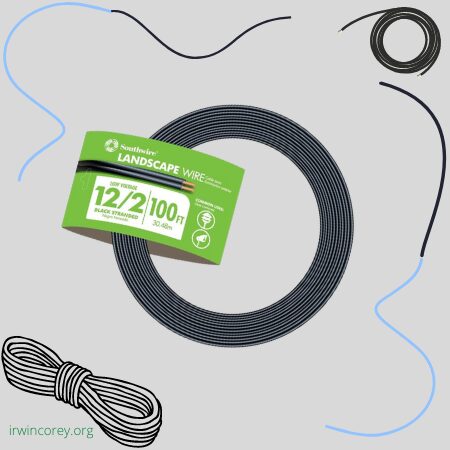
02. Lightkiwi
The wire that is by Lightkiwi is made with copper only. Since it is only made with copper, it becomes a great conductor and provides greater connectivity as compared to the other wires.
It comes with a heavy-duty jacket that prevents it from cuts and nicks. It provides great performance and reliability.
This wire also has the capability to withstand weather conditions and dust. It is versatile and can be used for different purposes.
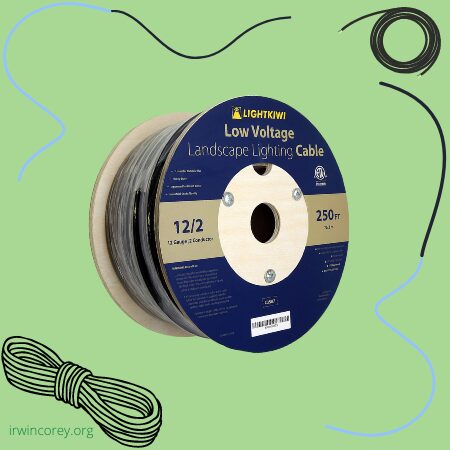
Steps For How to Wire Low Voltage Transformer
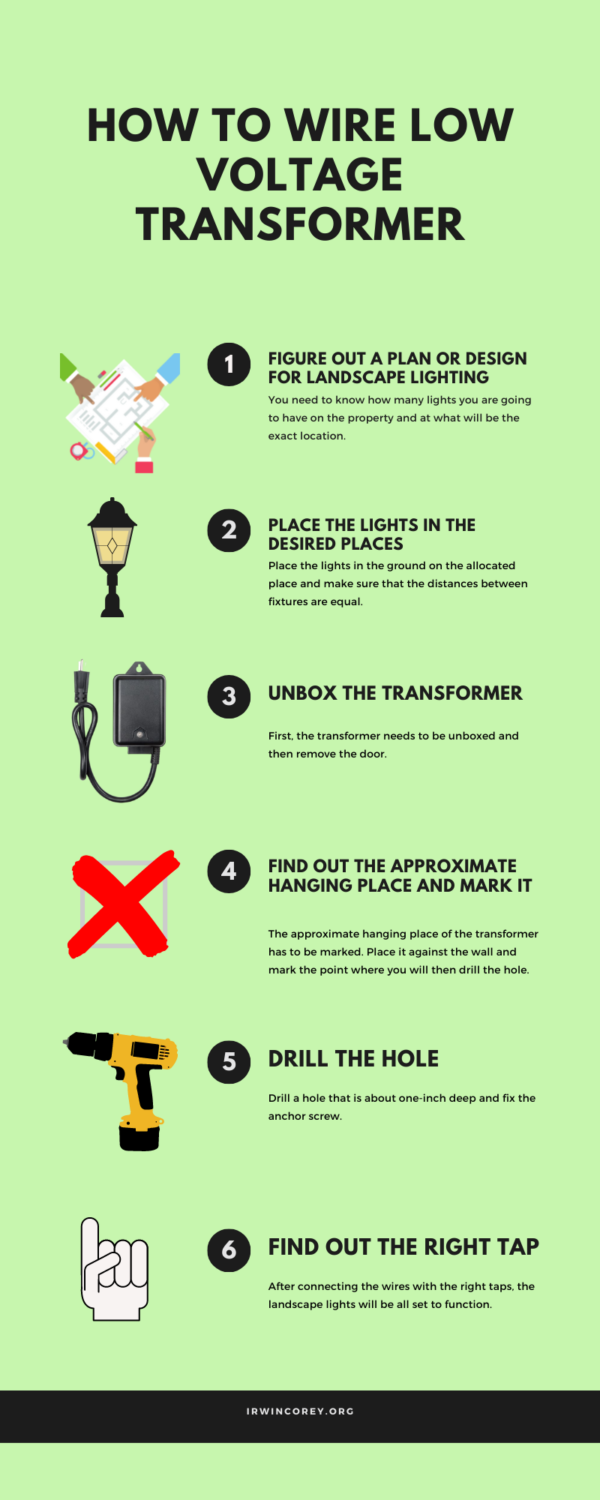
Figure out a plan or design for landscape lighting
The first step is to design or plan your landscape lighting. You need to know how many lights you are going to have on the property and at what will be the exact location.
This will then help in figuring out the size of the transformer. Then, get your hands on the right side of the transformer. Make sure that the transformer has enough room for future expansion.
Based on the plan, the lights may be placed sequentially. On the other hand, they may be placed in two groups. One load may be on the right side and the other load may be on the left side.
In this case, two separate sets of wires can be attached to the transformer. This is great especially when the transformer is heavy-duty.
However, if the lights have been placed sequentially then only one wire can also be attached to the transformer.
Place the lights in the desired places
According to the plan, place the lights in the ground on the allocated place and make sure that the distances between fixtures are equal. After that, dig along the length of the wires so that they can be hidden.
After fixing all the lights and fixtures, the transformer can be installed.
Unbox the transformer
First, the transformer needs to be unboxed and then remove the door.
Find out the approximate hanging place and mark it
Then, the approximate hanging place of the transformer has to be marked. Place it against the wall and mark the point where you will then drill the hole.
Drill the hole
Drill a hole that is about one-inch deep and fix the anchor screw. Then, hang the transformer vertically on the screw. Drill another hole at the bottom and then secure the transformer in place.
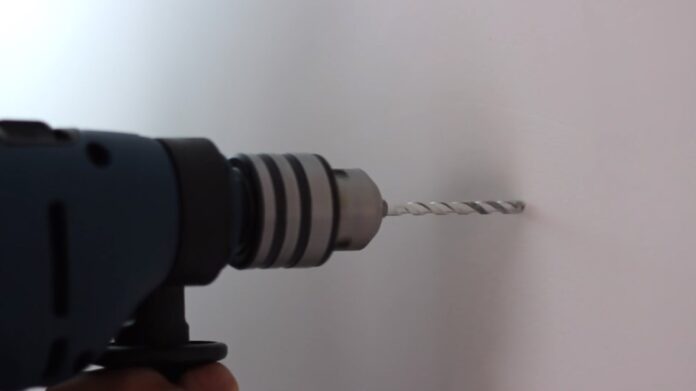
Find out the right tap
Now different transformers have different taps. Some have multiple taps where one is for commons and the others have different wattage. So, in that case, the maximum wattage is the best option to get started with.
After connecting the wires with the right taps, the landscape lights will be all set to function.
Tools for installation
There are not many complex tools that may be needed. The tools needed for wiring and installation are:
- Screwdrivers
- Drill machine
- Measuring tape
- Screws
- Fixtures
- Digging tools
- Wire scrappers
Time
The time needed to get done with the job depends upon the efficiency of the doer or homeowner.
The installation of the lights may take slightly longer but the installation of the transformer is pretty easy and it should not take much time.
Within 10-15 minutes, the installation of the transformer can take place.
However, the wiring may take hours depending upon the size of the property and depending upon the number of lights that need to be installed.
Cost
The price of each component of landscape lighting varies. The price range of transformers is $50-$400. It can even increase depending upon its capacity.
The wire may cost about $100. However, depending upon the size of the property you may need less or more of it. Hence, the price will vary.
The price of the lights ranges from $50 to $300. The price may be more or less, depending upon the number of lights and quality.
One thing to note is that the cheaper quality lights will mostly be cheaper. The cheaper quality lights will lead to a voltage drop.
How many lights low voltage transformer supports?
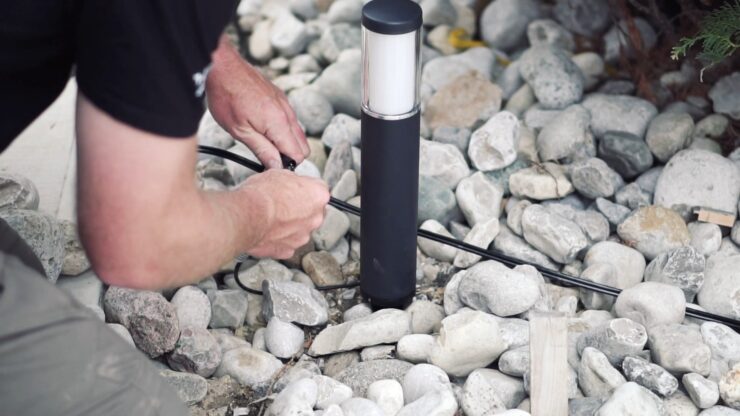
There are different low voltage transformers. Even in the category of low-voltage, transformers support, or sustain different power.
There are transformers that may support only eight lights and on the other hand, there are transformers that support around fourteen lights.
The wattage of the lights determines how many lights a transformer can support.
The thumb rule for this is that, calculate the total wattage of the lights. Now, the transformer should be at least 20% more of the total wattage of the lights.
If one light is supposed to consume 5 watts, it may not always consume 5 watts, sometimes it may consume 7 or even 10 watts. This is common in cheaper lights.
They may have a higher wattage than what is mentioned on the packaging. Having the transformer 20% of the total wattage prevents voltage drops and the lights keep running.
So, the number of lights supported by a transformer depends upon the total wattage of the lights.
What Size Transformer Do I need for low voltage lighting?
The size or capacity of the transformers ranges from 150-900 watts. However, to determine the size of the transformer, it is essential to know the number of lights in the design for landscape lighting.
The size of the transformer is dependent upon the number of lights and their wattage.
Once the total number of lights is figured out, the wattage of each of the lights can be added. After that, the size or capacity of the transformer can be picked according to the total wattage.
A Chart of 60W= How Many Lights?
The wattage of the lights varies. There are some with 10W, 12W, and even 24W.
Which types of lights best for low voltage landscape, string, pathway, driveway, backyard, front yard?
The low-voltage LED lights are definitely the best low voltage landscape, string, pathway, driveway, backyard, and front yard.
This is mainly because they are more efficient as compared to other kinds of lights. Along with that, LED lights are much more durable as compared to other lights.
The LED lights are capable of last for about 15-20 years. This is a pretty decent period of time.
Even though LED lights are slightly expensive, they are worth the money because they last much longer as compared to other cheaper lights. Cheaper lights require replacement more often as compared to LED lights.
Low Voltage Wiring Basics
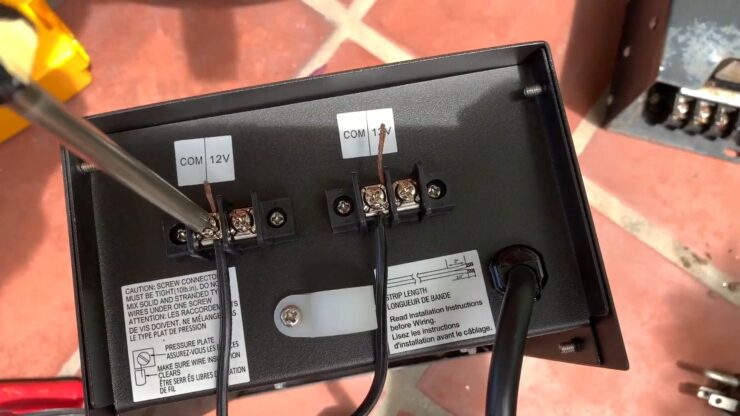
Do transformers come with accessories?
Some of the transformers come with additional features. The two most commonly known additional features are as follow:
#Timer
The timer is an advanced feature that allows the user to manually adjust the time of on and off of the lights.
# Photocell
A photocell is another amazing feature of the transformer. It basically turns on the lights at night and automatically turns them off in the morning.
Due to this, the user doesn’t have to manually adjust the on and off time of the transformer.
What are some reasons for voltage drop?
There are multiple reasons for voltage drop and some of them are:
Greater number of fixtures
If in one run of wire, there are multiple fixtures then it will lead to a voltage drop.
This is because too many fixtures will cause unequal distribution of power. Hence, all the lights will not be supported.
Longer runs of wire
Voltage drop is also caused by longer runs. The greater will be the distance, the voltage will decrease.
So, it is important to have smaller runs of wire and along with that, the wires should be equal between fixtures so that voltage drop can be prevented.
Uneven distribution of power
The power may be unevenly distributed because of daisy chains or for any other reason. When the power will not be evenly distributed, there will definitely be a voltage drop.
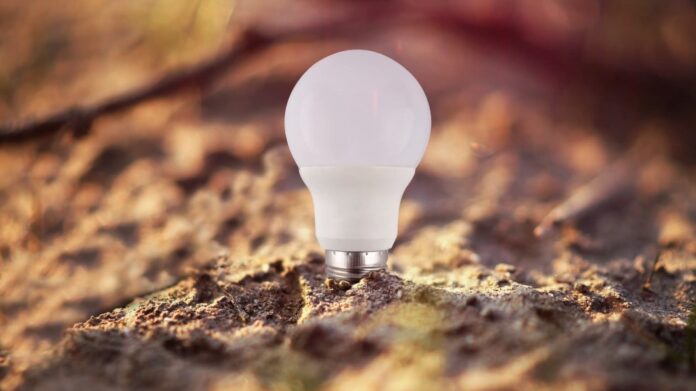
FAQs
What is the purpose of a low voltage transformer in landscape lighting?
A low voltage transformer converts the standard household power supply of 120 volts into a lower voltage (typically 12 volts) suitable for landscape lighting.
This not only makes the lighting more energy-efficient, but also reduces the risk of electrical hazards.
How do I choose the right low voltage transformer for my landscape lighting?
To choose the right low voltage transformer, first determine the total wattage of all the lights you plan to install. Then, select a transformer with a capacity at least 20% greater than the total wattage of your lights to ensure smooth operation and prevent voltage drops.
What are the steps for wiring low voltage lights with a transformer?
Follow these steps to wire low voltage lights with a transformer:
- Plan your landscape lighting design, including the number and location of lights.
- Choose the appropriate transformer based on the total wattage of your lights.
- Install the lights in their designated locations, ensuring equal distances between each fixture.
- Connect the wires from the fixtures to the transformer, ensuring proper connections and avoiding voltage drops.
What types of lights are best for low voltage landscape lighting?
Low voltage LED lights are the best choice for landscape lighting because they are energy-efficient, durable, and have a long lifespan of up to 15-20 years.
How can I prevent voltage drops in my low voltage lighting system?
To prevent voltage drops, ensure that the distance between fixtures is equal, avoid using too many fixtures on a single wire run, and choose a transformer with a capacity at least 20% greater than the total wattage of your lights.
Do transformers come with accessories or additional features?
Some transformers come with additional features such as timers and photocells. Timers allow you to manually set the on and off times for your lights, while photocells automatically turn the lights on at night and off in the morning.
How much time does it take to wire low voltage lights with a transformer?
The time needed to wire low voltage lights with a transformer depends on the size of the property and the number of lights to be installed.
Installing the transformer itself usually takes around 10-15 minutes, while wiring the entire system may take several hours.
Verdict
The wiring of low voltage landscape lights with transformer can be done by following a few steps. The crucial step is to know the total wattage of the lights that need to be installed.
Based on that wattage, a suitable transformer can be picked out. Once high-quality wires along with a suitable transformer are picked, the installation is pretty easy.
The lights need to be fixed with fixtures all over the property where the connecting wire is then attached to the transformer. The low voltage transformer then converts the high voltage of 120v into 12v.

